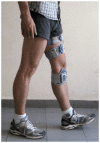Dual-channel functional electrical stimulation improvements in speed-based gait classifications
- PMID: 23467567
- PMCID: PMC3588608
- DOI: 10.2147/CIA.S41141
Dual-channel functional electrical stimulation improvements in speed-based gait classifications
Abstract
Background: Functional electrical stimulation (FES) is becoming an accepted treatment method for enhancing gait performance in patients who present with gait difficulties resulting from hemiparesis. The purpose of this study was to test whether individuals with hemiparesis who have varied gait speeds, which place them in different functional categories, benefit to the same extent from the application of FES.
Methods: Thirty-six subjects with chronic hemiparesis demonstrating foot-drop and deficits in knee and/or hip control were fitted with a dual-channel FES system activating the dorsiflexors and hamstring muscles. Gait was assessed during a 2-minute walk test with and without stimulation. A second assessment was conducted after 6 weeks of daily use. Analysis was performed with the subjects stratified into three functional ambulation classes according to their initial gait categories.
Results: The dual-channel FES improved the gait velocity of all three subgroups. No minimal gait velocity was required in order to gain benefits from FES. For example, subjects with limited household ambulation capabilities improved their gait speed by 63.3% (from 0.30 ± 0.09 m/sec to 0.49 ± 0.20 m/sec; P < 0.01), while subjects with functional community ambulation capabilities improved their gait speed by 25.5% (from 0.90 ± 0.11 m/sec to 1.13 ± 0.22 m/sec; P < 0.01).
Conclusion: Dual-channel FES positively affects gait velocity in patients with chronic hemiparesis, regardless of their initial gait velocity. Furthermore, gait velocity gains may be large enough to change an individual's ambulation status to a higher functional category.
Keywords: ambulation; functional electrical stimulation; gait velocity; hemiparesis.
Figures
References
-
- Bonita R, Solomon N, Broad JB. Prevalence of stroke and stroke-related disability. Estimates from the Auckland stroke studies. Stroke. 1997;28(10):1898–1902. - PubMed
-
- Lord SE, McPherson K, McNaughton HK, Rochester L, Weatherall M. Community ambulation after stroke: how important and obtainable is it and what measures appear predictive? Arch Phys Med Rehabil. 2004;85(2):234–239. - PubMed
-
- Daly JJ, Roenigk K, Holcomb J, et al. A randomized controlled trial of functional neuromuscular stimulation in chronic stroke subjects. Stroke. 2006;37(1):172–178. - PubMed
-
- Bohannon RW, Walsh S. Nature, reliability, and predictive value of muscle performance measures in patients with hemiparesis following stroke. Arch Phys Med Rehabil. 1992;73(8):721–725. - PubMed
Publication types
MeSH terms
LinkOut - more resources
Full Text Sources
Other Literature Sources
Medical
Miscellaneous



